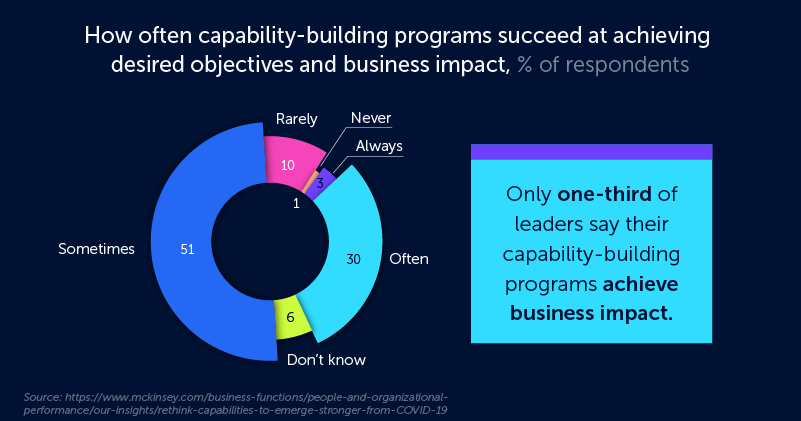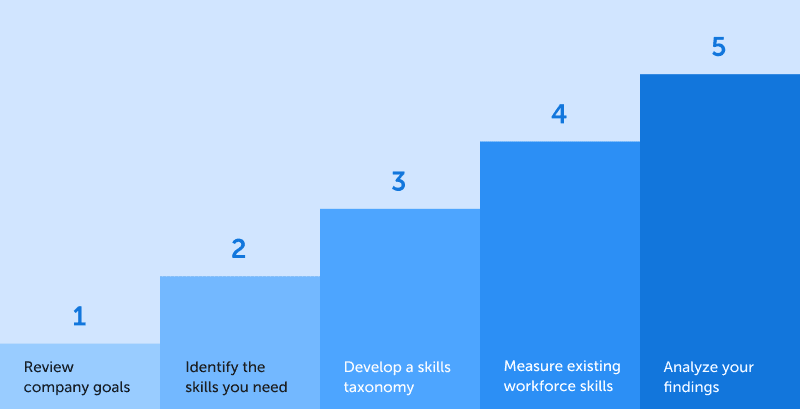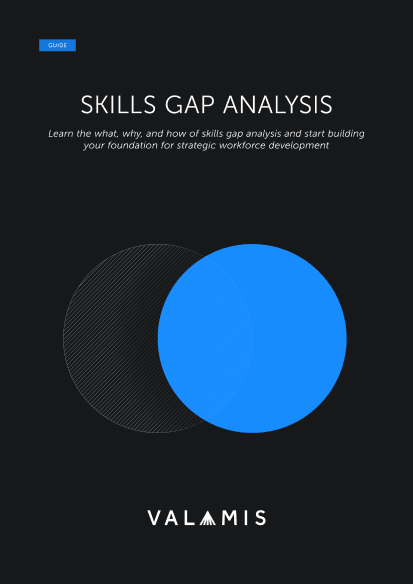Skills Management
Skills Gap
What is Skills Gap and How to Conduct Skills Gap Analysis
While skills gaps have always existed, workforces are currently undergoing dramatic changes that have exposed the shortage of expertise required for the new digital economy.
Therefore, in order to build an effective workforce for the future, organizations need to understand their existing skills gaps.
Discover:
- What is a skill gap?
- The three types of skills gaps
- Skills gap vs. performance gap. What is the difference?
- What is a skills gap analysis?
- Why do you need skills gap analysis?
- The importance of analyzing skill gaps in your company
- The challenges of addressing skills gaps
- 5 simple steps on how to conduct a skills gap analysis
What is a Skill Gap?
A skills gap is the difference between an employee’s current abilities and the skillset best suited for their job.
Companies have a desired set of skills to perform a given role successfully. This list of skills is dynamic and changes depending on external market forces and internal organizational changes.
Finding employees to match the required skills for every position is challenging; therefore, skills gaps exist.
Many factors can contribute to skill gaps:
- A lack of experience
- Inadequate training
- Poor recruitment
- Employee turnover
- Failures in the broader educational system
- Change in roles or responsibilities
Skills gaps can lead to workplace inefficiency, with staff struggling to handle their responsibilities or perform assigned tasks. In addition, severe skill gaps may lead to employees being unable to perform their roles.
In addition to focusing on an individual’s skills gaps, the concept can also be applied at a company-wide level.
Management can use skill gap assessments when introducing new procedures, technologies or take them into consideration when looking at work culture.
The Three Types of Skills Gaps
Skills gaps can exist in various forms. However, generally speaking, they can be separated into three main types:
- Knowledge Gap – a lack of knowledge related to the job. This could be the specific knowledge required to perform tasks successfully, the knowledge needed to understand how the work fits in the wider organization, or the institutional knowledge particular to a given organization. Removing knowledge gaps can improve employee performance and collaboration between staff members.
- Skills Gap – while knowledge generally refers to learning information and an individual’s intellect, skills refer to the ability to apply the proper knowledge in a given situation. Whereas employees can pick up knowledge through studying, skills must be performed. The skills needed for a particular job could be mental (e.g., coding ability), physical (e.g., fitness required for a physical role), or soft skills such as communication and emotional intelligence.
- Performance Gap – a lack of motivation or engagement leading to poor performance. Unlike the previous two types, performance gaps occur when an employee with all the tools to be successful underachieves. This could be for several reasons, including poor management or individuals being a bad cultural fit for the organization.
Skills Gap vs. Performance Gap. What is the Difference?
The concept of skills gaps can sometimes be confused with performance gaps. While similar, they describe different root causes for underperforming staff members.
| Skills gaps | Performance gaps |
|---|---|
| Refer to a lack of knowledge, expertise, or skills preventing an employee from maximizing the potential of a given role. | Refer to a lack of motivation or poor management misdirecting an employee’s efforts. |
| Occur when employees need to gain the skills, knowledge, or capabilities to apply them correctly to a given situation. | Occur when employees have the requisite skills but need more motivation or supervision to apply them effectively. |
| Examples could include understanding how an organization operates, how their work fits within wider processes, or the specific skills needed to fulfill the role, e.g., technical knowledge or soft skills. | Examples could include disgruntled employees with personal grievances in the workplace, new hires being a poor cultural fit, or managers failing to assign or oversee tasks correctly. |
What is a Skills Gap Analysis?
A skills gap analysis is the assessment of the difference between existing and desired skill sets. This can be applied to individual employees or an organization’s workforce as a whole.
Skills gap analysis takes a deep dive into an organization’s workforce to understand what each employee is currently capable of, what the ideal workforce would look like, and the steps needed to get there.

When implemented successfully, skills gap analysis guides future decisions regarding the company’s workforce (including L&D and hiring) to ensure each position is filled by employees with the necessary skills.
Skills gap analysis provides the information HR and management need to understand existing performance deficits and the potential lack of skills or knowledge behind them. This requires extensive employee performance evaluations to learn what is holding the organization back and where skills gaps are having the most significant impact.
Whether it is discovering smaller skills gaps that can be overcome through upskilling or reskilling programs or larger gaps that require new hires and the creation of new teams, without skills gap analysis, organizations struggle to build the workforce they need effectively.
The Importance of Analyzing Skill Gaps in Your Company
Why Do You Need Skills Gap Analysis?
Skills gap analysis offers a range of benefits, including:
- Providing a greater understanding of your existing workforce
- Boosting the impact of L&D programs
- Increasing your ROI from training initiatives
- Improving recruitment strategy
- Generating competitive advantages
- Building a workforce to meet modern demands
With new technologies finding widespread use across the business world, the need for skills gap analysis is only growing.
At a time when digitization and automation are redefining what companies need from their employees, skills gap analysis offers the roadmap to a better, more efficient way of working.
Even before the pandemic, the World Economic Forum estimated that half of all employees worldwide need reskilling to learn how to operate in the new technology-powered workplace. Skills gap analysis is the key to successful reskilling and upskilling programs and understanding where workforces need to improve.
Identifying any skills gaps present and understanding how they limit company performance is becoming essential thanks to new technologies transforming many business sectors.
With AI, automation, and other advances, many roles are becoming obsolete, and organizations need to source new skills to match growing technological needs. However, research by McKinsey in 2021 shows 87% of organizations expect to experience skills gaps in the coming years, with 43% saying they already have one.

A 2022 survey of CEOs by Deloitte found labor and skills shortages were the 2nd most cited external factor disrupting their business strategy. Also, with the rise of the digital economy, a Salesforce survey found that 76% of global workers don’t feel equipped to operate in new digitally-focused workplaces.
To respond to this gap, organizations must assess their existing workforce and develop active training programs and recruitment strategies to meet the moment.
Benefits of successfully overcoming skills gaps lead to a range of benefits, including:
- Developing a complete understanding of your workforce
- Greater productivity
- Improved agility
- Clear workforce planning strategy
- Competitive advantages over other organizations
The Challenges of Addressing Skills Gaps
While many workforces clearly have a problem, addressing skills gaps is challenging. Research from McKinsey found only 33% of capability-building programs always or often achieve the desired results.

So why is it so hard to overcome workforce skill gaps?
- The same McKinsey research found leadership plays a critical role in the success of skills gap programs, particularly in setting an example for employees. Surveys found that 65% of respondents believe executives should participate in L&D courses as trainers, facilitators, or learners. Leadership buy-in and modeling the same behavior asked of employees improves success rates when addressing skills gaps.
- Whether through training or hiring, overcoming skills gaps costs money. Many organizations want the benefit of an up-to-date productive workforce but are unwilling to make the investments necessary.
- Similarly, many organizations look to take shortcuts when it comes to addressing skills gaps. For example, McKinsey has developed a lengthy process around planning, developing, and implementing infrastructures to retrain employees post Covid. Their research found organizations that follow every step are 2.5x more successful than those that skip just a single stage.
- When looking to remove a workforce skills gap, it is easy to define the objectives; it is much harder to define the journey. Employees like to learn in different ways, and it can be challenging to implement appropriate formats that cater to everyone’s preferences. Whether it is digital learning, group workshops, expert coaching, or one of many other formats, the best skill gap programs are tailored for each employee.
Ways to fill the gap
There are various ways to fill skills gaps and develop a future-proof workforce. This includes training in the form of:
- Reskilling – training employees to transition to a new role
- Upskilling – adding new skills, so an employee improves at their existing role
- Digital training – focusing on the digital skills needed in the modern workforce
Or new hiring practices based on filling existing skills gaps and recruiting better-skilled staff.
Addressing workforce gaps requires extensive skill gap analysis, the process of determining the difference between what an organization needs from its staff and what it currently receives.
Skill gap analysis requires effective HR processes to accurately reflect the performance of employees and identify the skillsets and knowledge currently lacking or underdeveloped.
5 Steps on How to Conduct a Skills Gap Analysis
When done correctly, a skills gap analysis requires significant time and resources.
You must determine realistic business goals and the skills your workforce needs to make them a reality. This means assessing every employee’s ability, their effectiveness in their current role, how effective they would be in your newly envisaged operations, the ideal skillset they would have in the future, and how to bridge the gap between the existing and desired skills.

The process of skills gap analysis can be divided into five steps:
1. Review company goals
You can’t measure the size of a gap without knowing where you want to get to.
Defining clear company goals provides the framework for your skills gap analysis. It lets you identify the future skills you need, setting the benchmark to assess existing skills.
2. Identify the skills you need
To determine whether a particular skill is critical or not, consider whether its absence prevents an employee from completing a task to a high standard.
While many skills are desirable in the workplace, if an employee can successfully perform a role and collaborate with others without it, it is not a critical skill to future success.
3. Develop a skills taxonomy
Before assessing your existing workforce, a helpful step is to build a system for your desired skills, separating them with regard to the factors most relevant for your skills gap analysis.
You can use a Skills Matrix Template for this purpose. It is a great tool to assess the existing skills your organization has.
4. Measure existing workforce skills
Assessing your existing workforce skills and the gaps present can take many methods, from interviewing your employees to using specific software.
Your goal should be to find the right combination of techniques to most accurately reflect the reality of your workforce.
5. Analyze your findings
Now that you have all the data, it is time to analyze and characterize the existing skills gap in your workforce.
Download the full guide for details on each step and what to do next.




